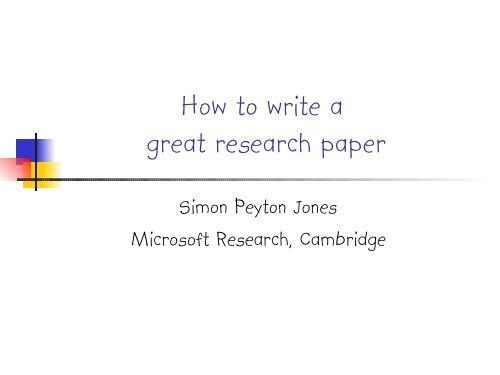How to write a great research paper
Create successful ePaper yourself
Turn your PDF publications into a flip-book with our unique Google optimized e-Paper software.
<strong>How</strong> <strong>to</strong> <strong>write</strong> a<br />
<strong>great</strong> <strong>research</strong> <strong>paper</strong><br />
Simon Pey<strong>to</strong>n Jones<br />
Microsoft Research, Cambridge
Why<br />
bother?<br />
Fallacy<br />
we <strong>write</strong> <strong>paper</strong>s and give<br />
talks mainly <strong>to</strong> impress<br />
others, gain recognition, and<br />
get promoted<br />
Good <strong>paper</strong>s and<br />
talks are a<br />
fundamental part of<br />
<strong>research</strong> excellence
Papers communicate ideas<br />
Your goal: <strong>to</strong> infect the mind of your reader with<br />
your idea, like a virus<br />
Papers are far more durable than programs (think<br />
Mozart)<br />
The <strong>great</strong>est ideas are (literally) worthless if<br />
you keep them <strong>to</strong> yourself
Writing <strong>paper</strong>s: model 1<br />
Idea<br />
Do<br />
<strong>research</strong><br />
Write <strong>paper</strong>
Writing <strong>paper</strong>s: model 2<br />
Idea<br />
Do<br />
<strong>research</strong><br />
Write <strong>paper</strong><br />
Idea Write <strong>paper</strong> Do <strong>research</strong><br />
Forces us <strong>to</strong> be clear, focused<br />
Crystallises what we don’t understand<br />
Opens the way <strong>to</strong> dialogue with others: reality check,<br />
critique, and collaboration
Do not be intimidated<br />
Fallacy<br />
You need <strong>to</strong> have a fantastic idea before you can<br />
<strong>write</strong> a <strong>paper</strong> or give a talk. (Everyone else seems<br />
<strong>to</strong>.)<br />
Write a <strong>paper</strong>,<br />
and give a talk, about<br />
any idea,<br />
no matter how weedy and insignificant it may seem<br />
<strong>to</strong> you
Do not be intimidated<br />
Write a <strong>paper</strong>, and give a talk, about any idea, no<br />
matter how insignificant it may seem <strong>to</strong> you<br />
<br />
<br />
Writing the <strong>paper</strong> is how you develop the idea in the<br />
first place<br />
It usually turns out <strong>to</strong> be more interesting and challenging<br />
that it seemed at first
The purpose of your <strong>paper</strong>
The purpose of your <strong>paper</strong> is...<br />
To convey<br />
your idea<br />
...from your head <strong>to</strong> your reader’s head<br />
Everything serves this single goal
The purpose of your <strong>paper</strong> is not...<br />
To describe the<br />
WizWoz system<br />
Your reader does not have a WizWoz<br />
She is primarily interested in re-usable brain-stuff, not<br />
executable artefacts
Conveying the idea<br />
Here is a problem<br />
I wish I knew<br />
how <strong>to</strong> solve<br />
that!<br />
It’s an interesting problem<br />
It’s an unsolved problem<br />
Here is my idea<br />
I see how<br />
that works.<br />
Ingenious!<br />
My idea works (details, data)<br />
Here’s how my idea compares <strong>to</strong> other people’s<br />
approaches
Structure<br />
Abstract (4 sentences)<br />
Introduction (1 page)<br />
The problem (1 page)<br />
My idea (2 pages)<br />
The details (5 pages)<br />
Related work (1-2 pages)<br />
Conclusions and further work (0.5 pages)
The abstract<br />
<br />
<br />
<br />
I usually <strong>write</strong> the abstract last<br />
Used by program committee members <strong>to</strong> decide<br />
which <strong>paper</strong>s <strong>to</strong> read<br />
Four sentences [Kent Beck]<br />
1. State the problem<br />
2. Say why it’s an interesting problem<br />
3. Say what your solution achieves<br />
4. Say what follows from your solution
Example<br />
1. Many <strong>paper</strong>s are badly written and hard <strong>to</strong><br />
understand<br />
2. This is a pity, because their good ideas may go<br />
unappreciated<br />
3. Following simple guidelines can dramatically<br />
improve the quality of your <strong>paper</strong>s<br />
4. Your work will be used more, and the feedback<br />
you get from others will in turn improve your<br />
<strong>research</strong>
Structure<br />
Abstract (4 sentences)<br />
Introduction (1 page)<br />
The problem (1 page)<br />
My idea (2 pages)<br />
The details (5 pages)<br />
Related work (1-2 pages)<br />
Conclusions and further work (0.5 pages)
The introduction (1 page)<br />
1. Describe the problem<br />
2. State your contributions<br />
...and that is all
Describe the problem<br />
Use an<br />
example <strong>to</strong><br />
introduce<br />
the problem
State your contributions<br />
<br />
<br />
<br />
Write the list of contributions first<br />
The list of contributions drives the entire <strong>paper</strong>:<br />
the <strong>paper</strong> substantiates the claims you have made<br />
Reader thinks “gosh, if they can really deliver this,<br />
that’s be exciting; I’d better read on”
State your contributions<br />
Bulleted list of<br />
contributions<br />
Do not leave the reader <strong>to</strong><br />
guess what your contributions<br />
are!
Contributions should be refutable<br />
We describe the WizWoz system.<br />
It is really cool.<br />
We study its properties<br />
We have used WizWoz in practice<br />
We give the syntax and semantics of a language<br />
that supports concurrent processes (Section 3).<br />
Its innovative features are...<br />
We prove that the type system is sound, and<br />
that type checking is decidable (Section 4)<br />
We have built a GUI <strong>to</strong>olkit in WizWoz, and<br />
used it <strong>to</strong> implement a text edi<strong>to</strong>r (Section 5).<br />
The result is half the length of the Java version.
No “rest of this <strong>paper</strong> is...”<br />
Not:<br />
“The rest of this <strong>paper</strong> is structured as follows. Section<br />
2 introduces the problem. Section 3 ... Finally, Section 8<br />
concludes”.<br />
Instead, use forward references from the<br />
narrative in the introduction.<br />
The introduction (including the contributions) should<br />
survey the whole <strong>paper</strong>, and therefore forward<br />
reference every important part.
Structure<br />
Abstract (4 sentences)<br />
Introduction (1 page)<br />
The problem (1 page)<br />
My idea (2 pages)<br />
The details (5 pages)<br />
Related work (1-2 pages)<br />
Conclusions and further work (0.5 pages)
No related work yet!<br />
Related<br />
work<br />
Your reader<br />
Your idea<br />
We adopt the notion of transaction from Brown [1], as modified for distributed<br />
systems by White [2], using the four-phase interpolation algorithm of Green [3].<br />
Our work differs from White in our advanced revocation pro<strong>to</strong>col, which deals with<br />
the case of priority inversion as described by Yellow [4].
No related work yet<br />
Problem 1: describing alternative<br />
approaches gets between the reader<br />
and your idea<br />
Problem 2: the reader knows nothing<br />
about the problem yet; so your (carefully<br />
trimmed) description of various technical<br />
tradeoffs is absolutely incomprehensible<br />
I feel<br />
tired<br />
I feel<br />
stupid
Instead...<br />
Concentrate single-mindedly on a narrative that<br />
Describes the problem, and why it is interesting<br />
Describes your idea<br />
Defends your idea, showing how it solves the problem,<br />
and filling out the details<br />
On the way, cite relevant work in passing, but defer<br />
discussion <strong>to</strong> the end
The payload of your <strong>paper</strong><br />
Consider a bufircuated semi-lattice D, over a hyper-modulated signature<br />
S. Suppose pi is an element of D. Then we know for every such p i<br />
there is an epi-modulus j, such that p j<br />
< p i<br />
.<br />
Sounds impressive...but<br />
Sends readers <strong>to</strong> sleep<br />
In a <strong>paper</strong> you MUST provide the details,<br />
but FIRST convey the idea
The payload of your <strong>paper</strong><br />
Introduce the problem, and your<br />
idea, using<br />
EXAMPLES<br />
and only then present the general<br />
case
Using examples<br />
The Simon PJ question:<br />
is there any type<strong>write</strong>r<br />
font?<br />
Example<br />
right away
Conveying the idea<br />
Explain it as if you were speaking <strong>to</strong> someone using<br />
a whiteboard<br />
Conveying the intuition is primary, not secondary<br />
Once your reader has the intuition, she can follow<br />
the details (but not vice versa)<br />
Even if she skips the details, she still takes away<br />
something valuable
Evidence<br />
Your introduction makes claims<br />
The body of the <strong>paper</strong> provides evidence <strong>to</strong><br />
support each claim<br />
Check each claim in the introduction, identify the<br />
evidence, and forward-reference it from the claim<br />
Evidence can be: analysis and comparison, theorems,<br />
measurements, case studies
Structure<br />
Abstract (4 sentences)<br />
Introduction (1 page)<br />
The problem (1 page)<br />
My idea (2 pages)<br />
The details (5 pages)<br />
Related work (1-2 pages)<br />
Conclusions and further work (0.5 pages)
Related work<br />
Fallacy<br />
To make my work look good, I have <strong>to</strong><br />
make other people’s work look bad
The truth: credit is not like money<br />
Giving credit <strong>to</strong> others does not diminish<br />
the credit you get from your <strong>paper</strong><br />
Warmly acknowledge people who have helped you<br />
Be generous <strong>to</strong> the competition. “In his inspiring <strong>paper</strong><br />
[Foo98] Foogle shows.... We develop his foundation in the<br />
following ways...”<br />
Acknowledge weaknesses in your approach
Credit is not like money<br />
Failing <strong>to</strong> give credit <strong>to</strong> others can kill<br />
your <strong>paper</strong><br />
If you imply that an idea is yours, and the referee knows it is<br />
not, then either<br />
<br />
<br />
You don’t know that it’s an old idea (bad)<br />
You do know, but are pretending it’s yours (very bad)
Making sure related work is accurate<br />
<br />
<br />
<br />
A good plan: when you think you are done, send the<br />
draft <strong>to</strong> the competition saying “could you help me<br />
ensure that I describe your work fairly?”.<br />
Often they will respond with helpful critique<br />
They are likely <strong>to</strong> be your referees anyway, so getting<br />
their comments up front is jolly good.
The process<br />
Start early. Very early.<br />
Hastily-written <strong>paper</strong>s get rejected.<br />
Papers are like wine: they need time <strong>to</strong> mature<br />
Collaborate<br />
Use CVS <strong>to</strong> support collaboration
Getting help<br />
Get your <strong>paper</strong> read by as many friendly<br />
guinea pigs as possible<br />
<br />
<br />
<br />
<br />
Experts are good<br />
Non-experts are also very good<br />
Each reader can only read your <strong>paper</strong> for the first time<br />
once! So use them carefully<br />
Explain carefully what you want (“I got lost here” is much<br />
more important than “wibble is mis-spelt”.)
Listening <strong>to</strong> your reviewers<br />
Every review is gold dust<br />
Be (truly) grateful for criticism as well as<br />
praise<br />
This is really, really, really hard<br />
But it’s really, really, really, really, really, really<br />
important
Listening <strong>to</strong> your reviewers<br />
Read every criticism as a positive suggestion for<br />
something you could explain more clearly<br />
DO NOT respond “you stupid person, I meant X”.<br />
Fix the <strong>paper</strong> so that X is apparent even <strong>to</strong> the<br />
stupidest reader.<br />
Thank them warmly. They have given up their time<br />
for you.
Language and style
Basic stuff<br />
Submit by the deadline<br />
Keep <strong>to</strong> the length restrictions<br />
Do not narrow the margins<br />
Do not use 6pt font<br />
On occasion, supply supporting evidence (e.g.<br />
experimental data, or a written-out proof) in an appendix<br />
Always use a spell checker
Visual structure<br />
Give strong visual structure <strong>to</strong> your <strong>paper</strong> using<br />
sections and sub-sections<br />
bullets<br />
italics<br />
laid-out code<br />
Find out how <strong>to</strong> draw pictures, and use them
Visual structure
Use the active voice<br />
The passive voice is “respectable” but it DEADENS your <strong>paper</strong>. Avoid<br />
it at all costs.<br />
“We” = you<br />
and the<br />
reader<br />
NO<br />
It can be seen that...<br />
34 tests were run<br />
These properties were thought<br />
desirable<br />
It might be thought that this would<br />
be a type error<br />
“You” = the<br />
reader<br />
YES<br />
We can see that...<br />
We ran 34 tests<br />
We wanted <strong>to</strong> retain these<br />
properties<br />
You might think this would be a<br />
type error<br />
“We” = the<br />
authors
Use simple, direct language<br />
NO<br />
The object under study was displaced<br />
horizontally<br />
On an annual basis<br />
YES<br />
The ball moved sideways<br />
Yearly<br />
Endeavour <strong>to</strong> ascertain<br />
Find out<br />
It could be considered that the speed of<br />
s<strong>to</strong>rage reclamation left something <strong>to</strong> be<br />
desired<br />
The garbage collec<strong>to</strong>r was really slow
Summary<br />
If you remember nothing else:<br />
Identify your key idea<br />
Make your contributions explicit<br />
Use examples<br />
A good starting point:<br />
“Advice on Research and Writing”<br />
http://www-2.cs.cmu.edu/afs/cs.cmu.edu/user/<br />
mleone/web/how-<strong>to</strong>.html











